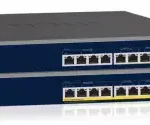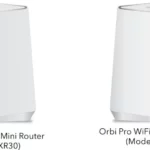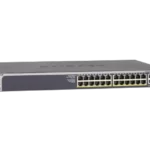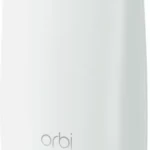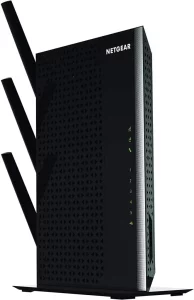

NETGEAR AC1900 Nighthawk WiFi Mesh Extender
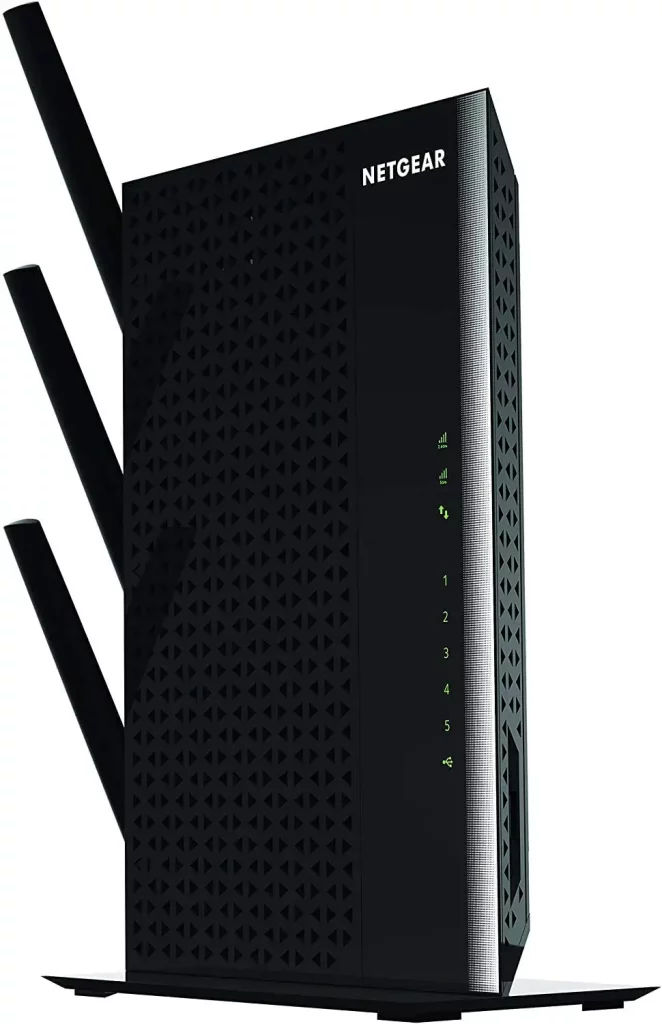
Getting Started
Does your WiFi router have a WPS button?
Yes No (or not sure)
Wi-Fi Protected Setup (WPS) is an easy way to connect WiFi devices. The button might look like one of these:
Yes
- Attach the antennas.
Remove the antenna caps. Attach the antennas to the connectors and turn them clockwise to tighten. Bend and rotate the antennas into position. Double-check that the antennas are properly tightened. - Turn on your extender.
Place the extender close to your WiFi router. Plug the extender into an electrical outlet. Press the Power button if necessary. - Connect to your WiFi router.
Press the WPS button on the extender. The Link Rate LEDs and Device to Extender LED blink green.
Within two minutes, press the WPS button on your WiFi router. After a few seconds, the 2.4 GHZ Link Rate LED lights green, indicating a good connection between your WiFi router and your extender. If the 2.4 GHz Link Rate LED does not light, or the LED is blinking amber, try again. If the LED still does not light, follow the instructions for No WPS button on the right. - Add a WiFi band.
If your WiFi router supports the 5 GHz band (not all routers do), and you want to extend that band, repeat Step 3 and check that the 5 GHz Link Rate LED lights solid green to confirm the connection. - Choose a location and check the signal strength.
Now that the extender is connected to your WiFi router, you can move it to a location that will boost your WiFi range. The location you choose must be within the range of your existing WiFi router network.
The Link Rate LEDs help you choose a spot where the extender-to‑router connection is optimal. See Indicator LEDs on the back to learn how the LEDs show the best connection.
If you get no connection or a poor connection, move the extender closer to your WiFi router and try again until the 2.4 GHz or 5 GHz Link Rate LED lights green. - Connect your WiFi devices.
Take your WiFi device to the location with poor WiFi router coverage. Connect your WiFi-enabled computer or mobile device to the WiFi network.
Note: Your extender uses the same WiFi network settings as your router for its 2.4 GHz and 5 GHz extended networks.
For example, if your extender connects to the router’s 2.4 GHz WiFi band, your extender uses your router’s 2.4 GHz WiFi settings for both its networks:
• Router 2.4 GHz WiFi network name. MyWiFiExample
• Router 5 GHz WiFi network name. MyWiFiExample-5G
• Extended 2.4 GHz WiFi network name. MyWiFiExample
• Extended 5 GHz WiFi network name. MyWiFiExample
If your extender connects to the router’s 5 GHz WiFi band, your extender uses your router’s 5 GHz WiFi settings for both its networks:
• Router 2.4 GHz WiFi network name. MyWiFiExample
• Router 5 GHz WiFi network name. MyWiFiExample-5G
• Extended 2.4 GHz WiFi network name. MyWiFiExample-5G
• Extended 5 GHz WiFi network name. MyWiFiExample-5G
Note: Since your router and extended networks share the same WiFi network name, only one WiFi network name is broadcast.
No (or not sure)
- Attach the antennas.
Remove the antenna caps. Attach the antennas to the connectors and turn them clockwise to tighten. Bend and rotate the antennas into position. Double-check that the antennas are properly tightened. - Turn on your extender.
Place the extender close to your WiFi router. Plug the extender into an electrical outlet. Press the Power button if necessary. - Connect to the extender.
Connect a computer or mobile device to the extender using a WiFi or Ethernet connection:
• WiFi. On your WiFi-enabled computer or mobile device, open the WiFi connection manager and locate and connect to the extender network called NETGEAR_EXT.
When your WiFi-enabled computer or mobile device is connected to the extender, the Client LED lights.
• Ethernet. Use an Ethernet cable to connect the Ethernet port on the extender to an Ethernet port on your computer. - Connect your extender to your router with a web browser.
Launch a web browser and visit www.mywifiext.net. The NETGEAR installation assistant displays.
Follow the prompts to connect your extender to your existing WiFi network. - Choose a location and check the signal strength.
Move your extender to a new location that is about halfway between your router and the area with a poor router WiFi signal. The location that you choose must be within the range of your existing WiFi router network.
The Link Rate LEDs help you choose a spot where the extender-to‑router connection is optimal. For more information, see Indicator LEDs.
If you get no connection or a poor connection, move the extender closer to your router and try again until the Link Status LED lights amber or green.
Front Panel and Side Panel
Rear Panel
Log In to Access Extender Settings
After installation, you can log in to the extender to view or change the extender’s settings.
To log in to the extender:
- Launch a web browser from a computer or mobile device that is connected to your extender network.
- Log in to your extender:
• If you did not enable the One WiFi Name feature, enter http://mywifiext.local in the address field of the browser.
• If you enabled the One WiFi Name feature, enter one of the following URLs:- Windows-based computer. http://mywifiext or http://mywifiext.local
- Mac computers, iOS devices, and Linux devices. http://mywifiext.local
- Android devices. http://<extender’s IP address> (for example, http://192.168.1.3)
To find your extender’s IP address, do the following:
a. Log in to your router.
b. Find the page in your router web interface that lists the devices connected to your router.
c. Find your extender in the list and note your extender’s IP address.
d. Enter your extender’s IP address in the address field of your web browser.
A login page displays.Indicator LEDs
- Enter your admin email address and password and click the LOG IN button. The Status page displays.
Indicator LEDs
Support
Thank you for purchasing this NETGEAR product. You can visit http://www.netgear.com/supportwww.netgear.com/support to register your product, get help, access the latest downloads and user manuals, and join our community. We recommend that you use only official NETGEAR support resources.
Trademarks
© NETGEAR, Inc., NETGEAR and the NETGEAR Logo are trademarks of NETGEAR, Inc. Any non‑NETGEAR trademarks are used for reference purposes only.

